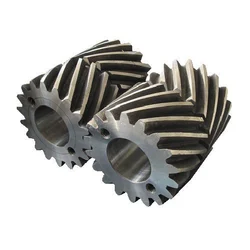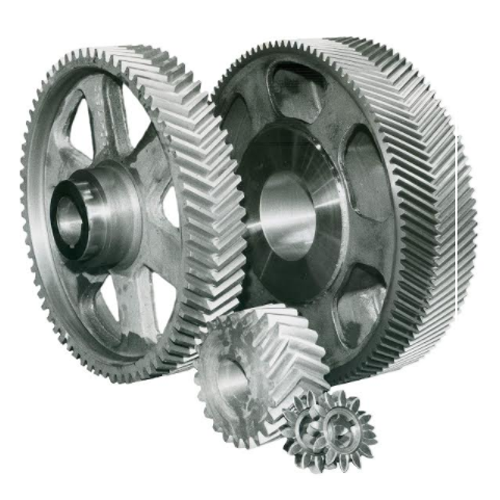Product Description
Heavy Industry Parts Hot Forging Steel Gear Shaft
Description
|
Product Name |
Gear Ring |
|
OEM |
Acceptable |
|
Materials |
35/1035 45/AISI1045 etc.Carbon Steel |
|
Max.Size |
Diameter≤φ10000mm |
|
Manufacturing Process |
Electroslag Remelting Hot Forging Turning Gear hobbing Gear milling Grinding |
|
Heat Treatment |
Normalizing Quenching Tempering Annealing Carburizing Nitriding Induction hardening |
|
Test Item And Method |
Chemical composition: Spectrum Analysis |
|
Application |
Gear Reducer Heavy Industry |
|
Package |
Plywood case |
|
Payment Term |
T/T, L/C |
OEM/ODM Request Is Very Welcome!
Production Process
We can produce various specifications of gear, meanwhile, we can also provide gear blanks.
We have a full set of production processes and testing instruments for forging, heat treatment and machining.
We have 5 medium frequency furnaces and 5 electric slag heavy furnaces, which can produce 1 ton-18 tons of various types of alloy steel, with an annual capacity of 10,000 tons. The main characteristics of electroslag remelting are that it can flexibly produce various types of special steel in size and batch, with pure composition, uniform and dense crystal organization.
Natural gas digital display computer temperature control heating CHINAMFG can accurately control the heating temperature of raw materials.
800T fast forging machine can quickly forge products, 3150T and 5000T oil press can forge heavy-duty axle products. They can guarantee the forging ratio required by the product, and ensure a good metallographic structure.
More than 20 digital display resistance CHINAMFG can be ignition, quenching and tempering products, at the same time, there are induction quenching and carburization process, so as to ensure the mechanical performance requirements of the gear.
Inspection
SYI regards Quality as the essential part of our business success. Based on your requirements, we have raw material in-coming inspection, process control and pre-shipment inspection. With advanced test equipments such as spectrometer, CMM, tensile strength tester, microstructure, hardness tester and etc, CHINAMFG is able to apply sufficient chemical and physical inspection. According to your request, we are also capable to do X-Ray, Magnetic Testing, Ultrasonic Testing and liquid Penetrant Examination.
Company
About Us
SYI provides OEM Casting & Forging services based on your drawings , samples , or just an idea ! After technical analysis and individual QCP for each project , the most suitable manufacture process will be recommended.
SYI starts our business since 1990 ‘ s of machined and un-machined in a variety of industry . We have over 100,000 products till now with the support of a specialized team including 50 engineers , inspectors and customer services .
Cooperative Brand
| Processing Object: | Metal |
|---|---|
| Molding Style: | Forging |
| Application: | Heavy Industry Machine |
| Material: | Steel |
| Heat Treatment: | Normalizing Quenching Tempering Carburizing Ni |
| Standard: | ASTM |
| Customization: |
Available
| Customized Request |
|---|

How do you install a herringbone gear system?
Installing a herringbone gear system requires careful attention to ensure proper alignment, engagement, and functionality. Here’s a detailed explanation of the steps involved in installing a herringbone gear system:
- Preparation: Before installation, gather all the necessary components, including the herringbone gears, shafts, bearings, and any associated hardware. Ensure that the gears and shafts are clean and free from any debris or contaminants that could affect their performance. Review the gear system’s specifications, including the gear ratios, torque requirements, and any specific installation guidelines provided by the manufacturer.
- Shaft Alignment: Proper shaft alignment is crucial for the smooth operation of a herringbone gear system. Align the shafts accurately to ensure that they are parallel and concentric with each other. This can be achieved using alignment tools such as dial indicators and laser alignment systems. Proper shaft alignment helps to minimize misalignment-related issues such as gear tooth wear, noise, and premature failure.
- Gear Engagement: Position the herringbone gears on their respective shafts, ensuring that they are correctly oriented and meshing properly. The double helical tooth profile of the herringbone gears requires careful engagement to prevent interference and ensure smooth operation. Pay attention to the gear backlash, which is the slight clearance between the gear teeth when they are not under load. Follow the manufacturer’s recommendations for the appropriate gear backlash and adjust as necessary.
- Bearing Installation: Install the appropriate bearings to support the gear shafts. Ensure that the bearings are aligned and properly seated in their housings. Use the specified lubrication method and apply the appropriate lubricant to the bearings to minimize friction and wear. Adequate lubrication is essential for the smooth operation and longevity of the gear system.
- Check Clearances: Once the gears, shafts, and bearings are installed, check for any interferences or clearances issues. Verify that there is sufficient clearance between the gear teeth, as well as between the gears and any adjacent components or structures. Ensure that there are no obstructions that could impede the rotational movement of the gears or cause damage during operation.
- Tightening and Fastening: Securely tighten all fasteners, such as bolts or set screws, to hold the gears, shafts, and bearings in place. Follow the recommended torque specifications provided by the manufacturer to ensure proper fastening without over-tightening, which could lead to excessive stress or deformation of the components.
- Testing and Adjustment: After installation, perform a thorough inspection and functional testing of the herringbone gear system. Rotate the shafts manually or using a suitable drive mechanism to check for smooth and proper gear engagement. Listen for any unusual noises, vibrations, or irregularities that could indicate misalignment or other issues. If necessary, make fine adjustments to the gear engagement, backlash, or shaft alignment to optimize the performance of the gear system.
It is important to note that the installation process may vary depending on the specific gear system design, size, and application requirements. Always refer to the manufacturer’s guidelines, technical documentation, and any applicable industry standards when installing a herringbone gear system to ensure proper installation and optimal performance.

What are the advantages and disadvantages of using herringbone gears?
Herringbone gears offer several advantages and disadvantages that should be considered when evaluating their suitability for a specific application. Here’s a detailed explanation of the advantages and disadvantages of using herringbone gears:
Advantages of Herringbone Gears:
- Reduced Friction: The double helical arrangement of the teeth in herringbone gears helps cancel out axial thrust and minimize sliding friction during gear meshing. This results in reduced frictional losses, improving overall efficiency and reducing energy consumption.
- Smooth Operation: Herringbone gears provide smooth and quiet operation due to their gradual meshing and unmeshing characteristics. The opposing helix angles of the teeth enable smooth tooth engagement, reducing impact and vibrations, and enhancing overall system performance.
- High Torque Capacity: Herringbone gears have a larger surface area of contact compared to spur gears, allowing them to transmit higher torque loads. This higher torque capacity enables the use of more compact gear designs and reduces the need for additional gear stages, resulting in space and weight savings.
- Better Load Distribution: The double helical tooth arrangement in herringbone gears distributes the load more evenly across the gear face. This improves load-bearing capabilities, reduces stress concentrations, and enhances gear life and durability.
- Improved Alignment: Herringbone gears are self-aligning to a certain extent due to their double helical structure. This makes them more forgiving of minor misalignments, simplifying the alignment process during installation and reducing the risk of gear tooth damage.
- No Axial Thrust: The opposing helix angles of the teeth in herringbone gears cancel out the axial thrust. This eliminates the need for additional thrust bearings or complicated thrust balancing mechanisms, simplifying the overall gear system design.
Disadvantages of Herringbone Gears:
- Complex Manufacturing: Herringbone gears are more complex to manufacture compared to spur gears. The double helical tooth profile requires precise machining and specialized manufacturing processes, which can increase production costs.
- Tighter Tolerance Requirements: The double helical tooth profile of herringbone gears requires tight manufacturing tolerances to ensure proper gear meshing and alignment. This may require more stringent quality control measures during production and assembly.
- Increased Axial Space: Herringbone gears require additional axial space compared to spur gears due to their double helical structure. This can be a constraint in applications with limited axial space availability, requiring careful consideration during system design.
- Higher Complexity in Gearbox Design: Incorporating herringbone gears into a gearbox design can add complexity to the overall system. The need for proper gear alignment, balancing, and lubrication may require more sophisticated gearbox configurations and maintenance procedures.
- Specialized Maintenance: Herringbone gears may require specialized maintenance procedures, such as gear tooth inspection, alignment checks, and lubrication. This can involve additional time and effort compared to simpler gear systems.
When considering the use of herringbone gears, it is essential to evaluate the specific requirements of the application, including load capacity, operating conditions, space constraints, and cost considerations. Proper design, manufacturing, and maintenance practices can help leverage the advantages of herringbone gears while mitigating their disadvantages.

Are there different variations of herringbone gears available?
Yes, there are different variations of herringbone gears available to suit specific application requirements. Here’s a detailed explanation of some of the common variations of herringbone gears:
- Single- and Double-Sided: Herringbone gears can be classified as single-sided or double-sided based on the number of helical sections. Single-sided herringbone gears have a herringbone tooth profile on one side and a straight tooth profile on the other side. Double-sided herringbone gears have herringbone tooth profiles on both sides. Single-sided herringbone gears are commonly used when axial thrust elimination is not a primary requirement, while double-sided herringbone gears provide superior axial thrust cancellation.
- Conventional and Low-Backlash: Herringbone gears can also be categorized as conventional or low-backlash based on their tooth design and manufacturing precision. Conventional herringbone gears have standard tooth profiles and may exhibit some level of backlash, which is the slight clearance between the mating teeth. Low-backlash herringbone gears are designed and manufactured with tighter tolerances to minimize or eliminate backlash, resulting in improved precision and reduced vibration.
- Materials and Coatings: Herringbone gears can be made from various materials depending on the application requirements. Common materials include steel, cast iron, bronze, and non-ferrous alloys. Additionally, surface coatings such as nitriding or carburizing can be applied to enhance the gear’s hardness, wear resistance, and durability. The choice of material and coating depends on factors like load capacity, operating conditions, and cost considerations.
- Customized Geometries: Herringbone gears can be customized to specific geometries and specifications based on the application requirements. This includes variations in tooth dimensions, helix angles, pressure angles, and gear module (the ratio of the gear’s pitch diameter to the number of teeth). Customized geometries allow herringbone gears to be optimized for specific torque loads, speed ranges, and space constraints.
- Integrated Components: In some applications, herringbone gears may be integrated with other components to form specialized gear systems. For example, herringbone gears can be combined with planetary gear systems to create herringbone planetary gears, which offer high torque capacity and compact design. These integrated variations provide specific advantages in terms of load distribution, torque transmission, and overall system efficiency.
The choice of herringbone gear variation depends on the specific application requirements, including factors such as torque loads, speed ranges, axial thrust considerations, precision requirements, and space limitations. Manufacturers and engineers can select the most appropriate variation or customize herringbone gears to ensure optimal performance and reliability in their respective applications.
In summary, herringbone gears offer different variations such as single-sided and double-sided configurations, conventional and low-backlash designs, variations in materials and coatings, customized geometries, and integration with other gear systems. These variations allow herringbone gears to be tailored to meet the specific needs of diverse industrial applications.


editor by CX 2023-10-07